Jewish Usury in the Middle Ages - 09/09/09
11 AM - 1 PM : Jewish Usury in the Middle Ages By William Finck
Christogenea is 100% reader supported. If you find value in our work, please contribute and help to keep it going! See our Contact Page for more information!
11 AM - 1 PM : Jewish Usury in the Middle Ages By William Finck
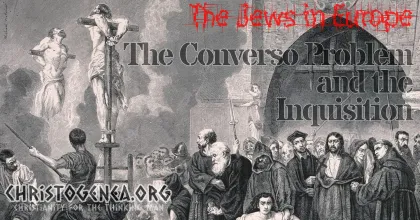
The Jews in Europe: The Converso Problem and the Inquisition, Part 1
Over these last several months we have spent a lot of time discussing the early years of the Reformation relative to the life of Martin Luther. Discussing things such as the rise of humanism in Germany and the Reuchlin affair, as well as the fact that the support of humanists was crucial to the success of Luther’s cause in the years after the Reuchlin affair, we had frequently stated that we wanted to better quantify the role of the Jews who were indeed operating behind the scenes of these events.
There were, of course, converso Jews who were operating out in the open, and they could do so because they were supposed converts. Presenting Martin Luther’s On the Jews and Their Lies, we discussed the many converso Jews whose writings Luther had studied, and whose arguments he had adopted and employed against religious Jews. So Martin Luther himself had gotten much of his theological understanding from the Jews. But, for an even more pertinent example, we had also pointed out how Johannes Pfefferkorn, one of the leading voices against Johannes Reuchlin, was himself a converso Jew who had taken it upon himself to assume the role of spokesman for those who were opposed to Reuchlin, stepping out in front of the more traditionally conservative Dominican monks. We hope to have made it apparent that the Dominican monks had a dispute with Reuchlin with or without Pfefferkorn, but the converso Jew nevertheless became the leading voice and agitator for action.
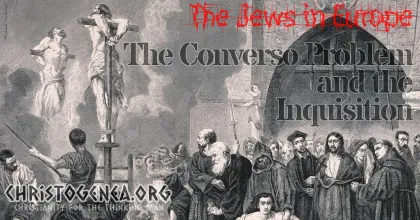
The Jews in Europe: The Converso Problem and the Inquisition, Part 2
Here we shall offer a summary background loosely based upon what we had seen in the first segment of this presentation, adding a few of our own opinions.
After the Visigoths of Spain had converted to Christianity, and began to regulate their kingdom with Christian principles, life for the Jews became quite intolerable. Laws were made whereby Jews could no longer lend money to Christians on usury, Jews could no longer hold office or rule over Christians, and other laws by which they could no longer live as parasites on the larger White society. Jews had thrived for centuries in pagan Spain, and the parasites were not going to let themselves be deprived of such a profitable host. So in the 7th century the Jews reacted by bringing the moslems into Spain in order to destroy the Gothic kingdom. Perhaps around two-thirds of the Iberian peninsula came to be ruled and also occupied by Arabs and Moors for over 7 centuries. But when the moslems were finally being forced out in the Reconquest, the Jews remained, their role in the moslem invasion being quite obscure to most all Spaniards, and, unfortunately, even to most Christians today.
We can search out the events leading up to the moslem invasions of North Africa and Spain, and we may find that Jews created the moslem religion for the very purpose of organizing the Arab hordes against Christendom. While that is outside of the scope of our purpose here, the result stands as the first proof of the assertion.

The Jews in Europe: The Reuchlin Affair Revisited, Part 1
Over these last several months we have spent a lot of time discussing the early years of the Reformation relative to the life of Martin Luther. Discussing things such as the early humanists in Germany and the Reuchlin affair, we had frequently stated that we wanted to better quantify the role of the Jews who were indeed operating behind the scenes of these events. Since that time, we have learned that E. Michael Jones, in his book The Jewish Revolutionary Spirit and its Impact on World History, has done much of that research for us. Therefore we are going to make a presentation of chapter 7 of Jones’ book, which is titled Reuchlin v. Pfefferkorn. We believe that revisiting the Reuchlin Affair from Jones’ enhanced perspective, where he focuses on aspects of the Jewish question which our German historians had neglected, will not only enhance our understanding of the nature and objectives of some of Luther’s supporters during the Reformation, but also exhibit for us the Jewish mentality that agitated the later Revolutions in Europe and produced the Protocols of Zion. Both of these topics are of great interest in relation to our presentations here over the last year, and those which we hope to make here in the near future.
So without further introduction, we shall commence with E. Michael Jones:
Roughly 270 years after Nicholas Donin persuaded Pope Gregory IX to allow him to proceed against the Talmud, another Jew converted to Christianity and had the same idea. In 1504, Josef Pfefferkorn, a Moravian Jew, converted to Christianity, along with his wife and child. After changing his name to Johannes at his baptism, Pfefferkorn spent his first years as a Christian wandering through southern German-speaking lands preaching the conversion of the Jews. In 1509 he settled in Cologne, where he made contact with the Dominicans, who had promoted Donin's efforts to convert the Jews three centuries earlier. Pfefferkorn's enthusiasm for the Christian faith was undeniable, but the results of his preaching were meager. In 1516, at the height of his fame, he claimed he had converted 14 Jews after years of effort. He claimed another five would have entered the Church if the Jews hadn't blackened his name. Pfefferkorn would become famous as a publicist, not as a preacher. The printing press was transforming the movement of information in Europe, and he made good use of this new technology.

In the first segment of our presentation from chapter 7 of The Jewish Revolutionary Spirit and its Impact on World History by E. Michael Jones, we saw how it was that Johannes Reuchlin, a trained lawyer and a man who in his own time was widely considered to be one of the greatest scholars in Europe – second only to Erasmus of Rotterdam – became infatuated with the Kabbalah and took upon himself the role as defender of the Talmud and the other anti-Christian writings of the Jews. However it is important to understand that this was only a part, although it was a significant and important part, of the much wider unrest within the Church itself in regard to literary and scientific studies. Jones had stated in the first part of this chapter that “Humanistic studies of the sort promoted by Erasmus of Rotterdam had suggested that a new day of Enlightened tolerance was about to dawn after the long night of scholastic obscurantism, and so the Jews were emboldened to act.”
It is readily evident that at this time the limitations which the institutions within the Roman Catholic Church had long imposed upon the study and publication of profane literature were being increasingly rebelled against by men within those Church institutions, and Erasmus was a leader in that struggle. In Part 3 of our series on Martin Luther in Life and Death, we had said the following about Erasmus:
“… the celebrated Catholic priest, Erasmus, was actually a humanist and not at all a Christian. In turn, Erasmus had fostered the development of an entire collection of fellow humanists inside the Catholic church organization in Germany….”

The Jews in Europe: The Reuchlin Affair Revisited, Part 3
This is now the third, and final, segment of our presentation from chapter 7 of The Jewish Revolutionary Spirit and its Impact on World History by E. Michael Jones, which is titled Reuchlin v. Pfefferkorn. Here we see that from one of the first episodes of the Reformation, the future of academia in Europe is stuck in a dichotomy which we may describe as the self-hating Jew vs. the wannabe Jew. This is because Pfefferkorn, a Converso Jew, had made himself an advocate for the Dominican monks who wanted to rid Germany and the empire of the wicked writings of the Jews found in the Talmud, the Kabbalah, and other Medieval books. But Reuchlin, the German Christian, became fascinated with the Kabbalah and other writings of the Jews to the point of wanting to install Jews into the universities as teachers of Hebrew and Theology, while he had admittedly never even read the Talmud.
To the advantage of all Jews, the argument was quickly characterized anew as being between the humanists and the scholastics, even thought the primary issue remained centered on the Jewish literature. The scholastics, represented by the Dominican monks, wanted to eradicate the Jewish books because they saw them as an impediment to their goal of bringing the Jews as converts into the Catholic orthodoxy, naively imagining that the books themselves were the cause of historically anti-Christian Jewish behavior. While the scholastics were defenders of traditional Catholicism against the Jews, they were also traditional universalist Catholics, who would readily accept presumed converts from Judaism. The humanists rallied to the cause of the Judaizing Reuchlin because they saw an opportunity to put an end to Roman Catholic obscurantism, as they called it, which limited the studies of the universities to those books approved by the Roman Catholic theologians.
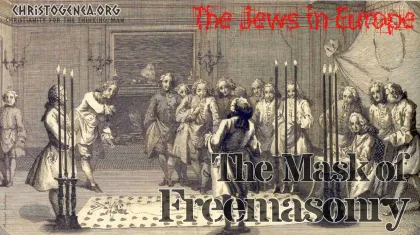
The Jews in Europe: The Mask of Freemasonry, Part 1
Some of the denizens of the Christogenea chat server have already scolded me for procrastinating, and forestalling a continued presentation of the Protocols of Satan. However I found it necessary to do so, because in the first 7 segments of the series we went to great lengths to demonstrate that The Protocols of the Learned Elders of Zion were indeed what they are believed to be by many of the so-called “conspiracy theorists”: a boastful outline of the plans of Jewry for the final subjugation and control over the nations of Christendom. Doing this, we showed, largely from the work of Nesta Webster, that many of the statements in the Protocols had been expressed throughout the literature of both members and founders of the various secret societies of 18th and 19th century Europe, as well as that of the early leaders of the Marxist Communists.
Doing all of this, we presented the thesis that the Jews were indeed behind the Protocols of Zion, as it is claimed, and that the secret societies were the primary vehicle through which the Jews had been able to execute the plan for world conquest which the Protocols represent. However before proceeding with a presentation of the Protocols themselves, we determined that it was necessary to provide some of the glue necessary in order to secure that thesis. So we presented the chapter on the Spanish Inquisition from E. Michael Jones’ book The Jewish Revolutionary Spirit and its Impact on World History, and we did that, in part, in order to show that the mentality of the Jews of Europe in the 15th century was exactly similar to the mentality of the Jews as it is exhibited in the Protocols of Zion. Then we presented anew the Reuchlin Affair from E. Michael Jones’ perspective, with sufficient of our own comments, first in order to better elucidate the Jewish influence behind the humanist factions of the Reformation, and then to show that the naive German fascination with the Kabbalah of the sort exhibited by Reuchlin was the opportunity which the Jews took advantage of to lure men into their secret societies.

The Jews in Europe: The Mask of Freemasonry, Part 2
Out of all the literature of the ancients, only one book instructs man as to the treachery of the people now known as the Jews, and that book is the Bible, of which both Old and New Testaments are equally relevant parts. To realize this truth, the Bible must be treated as the history book which it is, and studied forwards and backwards and forwards again in conjunction with all of the other ancient documents which we have available. These people now known as Jews can be traced from Genesis chapter 4 through the early periods of Joshua and the Judges and into the kingdom of David and Solomon, and the prophets describe how they infiltrated, eventually subverted, and caused the downfall of that kingdom. The first humanist revolt was in the days of Jeroboam I, and by the time of Jeremiah and Ezekiel Jerusalem was nearly completely subverted, much like all of the western nations of today. But at that time the progenitors of the modern Jews were known as Canaanites, Shelahites and Hittites and others.
Rebuilding the Kingdom during the rather egalitarian Hellenistic period Judaea was infiltrated and subverted once again. Then by the time of the birth of Christ the Edomites, who were also Canaanites, took over the nation in a Bolshevik Revolution of their own, which culminated in the reign of Herod the Edomite. Christianity was born in the face of that revolution, and it is the only world religion which explicitly and specifically identifies its agitators as the devils which they are. Later in the first century, the Edomites attempted to carry their revolution throughout the entire empire, and continued it for over 60 years. It did not end in 70 AD, but rather in 136 AD after the Kitos War and the Bar Kokhba Rebellion had also failed. In this respect, Flavius Josephus, with all of his otherwise honorable intentions, was one of their shiksas. He wrote his work Wars of the Judaeans in Aramaic at the start of the first Judaean revolt, addressing it to some of the so-called “lost tribes” which he could still identify, the “northern barbarians” such as the Alans and the Parthians, hoping that he could encourage them to join the cause against Rome. But the Jews failed, and when Christianity prevailed in Europe in spite of three centuries of Jewish and Roman persecution, the Jews were crushed. By the sixth century they were ostracized from all of European society for the first and only time in history. So the Jews made war on Europe, enlisting the arabs, turks and mongols, until working from within they could finally subvert it once again. However the Jews, being the post-Christian left-over infiltrators of ancient Judaea, thereby maintained the identity as the people of the Bible which they had pilfered back in the second and first centuries BC. In truth, they are for the most part Edomites, and not Judaeans at all (Revelation 2:9, 3:9).

To begin this evening’s program, I want to repeat a paragraph which we had presented in our last segment of this series, from pages 333-335 of The Freemason’s Manual, written by one Jeremiah How and published in 1881. We are doing this first to buttress the claims of our source volume for this series, The Plot Against the Church, which asserts that Freemasonry is a product of World Jewry and has been used as a vehicle to subvert Western Civilization, and also to reiterate my assertions concerning any connections alleged between the more ancient Knight’s Templar and Freemasonry. Here Jeremiah How is writing in reference to the so-called “Royal, Exalted, Religious and Military Order of Masonic Knights Templar”, which is evidently an order and a degree within Freemasonry.
There is much difference of opinion as to the origin of this degree of the Masonic Institution, and without attempting to show that the form of conferring the degree is identical with that of the gallant and devoted soldier-monks of the Crusades, it cannot be controverted that their Institution possessed some features of similarity to Freemasonry. The connexion between the Knights Templar and the Masonic Institution has been repeatedly asserted by the friends and enemies of both. Brother Lawrie says, ‘We know the Knights Templar not only possessed the mysteries, but performed the ceremonies, and inculcated the duties of Freemasons;’ and he attributes the dissolution of the Order to the discovery of their being Freemasons, and assembling in secret to practise the rites of the Order. He endeavours to show that they were initiated into the Order by the Druses, a Syrian fraternity which existed at that date, and indeed now continues.
In a French MS. ritual of about 1780, in the degree of Black and White Eagle (30°), the transmission of Free masonry by the Templars is most positively asserted. The history of the Templars and their persecution is minutely described in the closing address, and the Grand Commander adds, ‘This is, my illustrious brother, how and by whom, Masonry is derived, and has been transmitted to us. You are now a Knight Templar, and on a level with them.’
We are going to reassert, that it is our opinion that the whole story about Freemasonry getting into Europe through the Knights Templar is an absolute fabrication. It is a cover story shielding the Jews from exposure as the real force behind Freemasonry. If it were true, it would suppose that Freemasonry had a more noble origin than the Medieval scholars, Jewish interlopers and outright frauds who were promoting the use of the Kabbalah to Christians. But even the sect of the Druze is founded upon Judaism, and modern Druze today even sit in the Israeli parliament in Palestine. Furthermore, the Knight’s Templar allegedly became wealthy through a mixed system of donations and usury, a vocation rather exclusive to the Jews in 13th century France. There may have been similarities between the Templars and the Masons only because they had the same influences. Furthermore, the Kabbalah is not a part of Druze literature, but a product of Jewish literature created in Medieval Europe, and it is the basis for Freemasonry as well.

The Jews in Europe: John Dee and the Kabbalah, Part 1
Our purpose here, before beginning a presentation of The Protocols of the Learned Elders of Zion, or as we like to more appropriately title them, The Protocols of Satan, is to demonstrate that Kabbalistic thought had permeated Britain and was in a position where it could captivate the minds of many an unsuspecting Englishman right at a time when scientific thought and liberty of conscience were becoming popular ideas in the concurrent wars of religious reformation of Europe. This kabbalistic thought would lend to the formation of modern Freemasonry and the secret societies of Europe from which all of the subsequent revolutions were launched which overturned Christian society and resulted in world Jewish supremacy.
A child was being born, and Satan could not kill it, so he persecuted and made war against its mother. In the Protocols, the objectives of the Jews and the agenda which to a large degree has been executed with the help of the lodges of Freemasonry come together as one, and are fully expressed.
To introduce the Kabbalah as a godly authority to otherwise Christian scholars is tantamount to giving the Jewish rabbis religious authority over countless Christian minds. This is what was happening in the Freemasonic lodges of Europe through the 18th and 19th centuries, and it is still ongoing today, whether or not lower-level Freemasons and its initiates realize this objective. That is because it is done not in the name of religion, although religion plays a role in the Freemasonic mantras and rituals, nor in the name of politics, although the end result is political. Rather, it is done in the name of science and scientific inquiry.
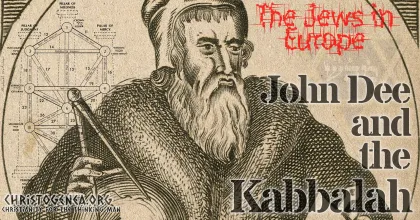
Here we are going to continue to present some aspects of the life of John Dee as they were recorded in a biography of the English alchemist, mathematician, and mystic. Our primary source is the biography of John Dee which was written by Charlotte Fell Smith and published in 1909. By the time we are finished, we hope to establish that John Dee was an advocate of the Jewish Kabbalah, through which he had introduced Jewish mysticism into the intellectual circles of 16th century England, just as Johann Reuchlin had done in Germany a few decades earlier. As we also hope to illustrate, the impact this would have on history cannot be overstated.
The year is 1583, and the Polish Prince Laski is in England. A French ambassador of the time speculated that Laski was in England to persuade the Muscovy Company to stop selling arms to the Russians. He certainly did not go merely to see John Dee. But Laski was also an alchemist, and very interested in John Dee, whom he insisted on meeting and being entertained by quite frequently almost as soon as he had arrived in London. Charlotte Fell Smith basically dismisses the idea that John Dee was a spy. In chapter 13 of her biography (pp. 168-169) she says “Dee's letters to Walsingham, with their veiled allusions to secret affairs, form one of the grounds upon which the supposition has been based that he was employed by the Queen's minister as a secret spy and diplomatic agent abroad, and that his kabbalistic diagrams contained a cipher. An elaborate theory was constructed to support this contention.” However, when considering the possibility that in his later trips abroad John Dee was acting as a spy for the English court, we must remember that the Queen herself had financed Dee’s ability to entertain Prince Laski and his entourage. So Elizabeth seemed to have encouraged Dee’s developing a relationship with Laski. But the financing did not endure. It must also be noted, that in her biography Charlotte Fell Smith had several times already described Dee’s troubles securing his diaries in a household replete with servants and fellow-workers. Those fellow-workers, namely his scryer Edward Kelley, had often caused Dee troubles, and therefore if Dee were a spy, he had every reason not to include the information in his biography. So while we do not accept much of the conjecture of the conspiracy theorists, we cannot rule out the possibility that Elizabeth encouraged Dee’s travels abroad so that he may report back to her any information he may gather. However on the other hand, Elizabeth being a long-time friend and patron of John Dee, that well-known relationship which he had with the English queen must have preceded him, and it would only have been natural for him to report to her anything which he had seen abroad.
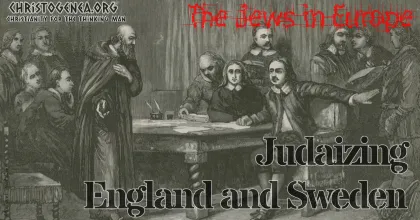
The Jews in Europe: Judaizing England and Sweden
Before we proceed with a short summary of the Jewish presence and influence in 17th century England, we should take a brief moment to look at the Jewish presence and influence in contemporary Sweden. Perhaps the Swedes missed an opportunity in saving England from Judaism, at least temporarily, when Christina the Swedish queen rejected the advances of Manasseh ben Israel. But in truth, she had already had enough Jews of her own.
We do not like to use Jewish sources for our studies, and we strongly dislike quoting Jews unless we are quoting them critically. But on some topics relating to Jews, some of their writers are worthy of quoting, so long as we can corroborate their statements independently. So the following excerpt is from a book written by a Jew named David S. Katz, entitled Menasseh ben Israel’s Mission to Queen Christina of Sweden, 1651 - 1655:
With perfect hindsight, one often sees Menasseh ben Israel’s career as leading inexorably to his mission to Oliver Cromwell in 1655, when he came to London to plead for the readmission of the Jews to England, nearly four centuries after their expulsion. At least this is how the events of the 1650s appear if one begins with the Whitehall Conference of 1655 and follows the thread back to the first tentative overtures toward England from Amsterdam. Even after the publication of The Hope of Israel in 1650, however, it was not apparent that Menasseh would soon be devoting himself to the cause of Anglo-Jewry. On the contrary, it was immediately after the appearance of the rabbi’s influential book that he began maneuvering for a place in the retinue of the notorious Christina, queen of Sweden. Only after he failed to obtain a position among her band of foreign scholars did Menasseh devote himself wholeheartedly to the readmission of the Jews to England. Other Jews had managed to win themselves a place in Christina’s circle. so Menasseh’s scheme was quite practicable. If Queen Christina had accepted the rabbi’s proposals with more alacrity, the history of seventeenth century Anglo-Jewry would have been very different indeed.
Christogenea is reader supported. This month's support level is reflected in the graph below. See our Contact page for a mailing address and other ways to support Christogenea.
31%